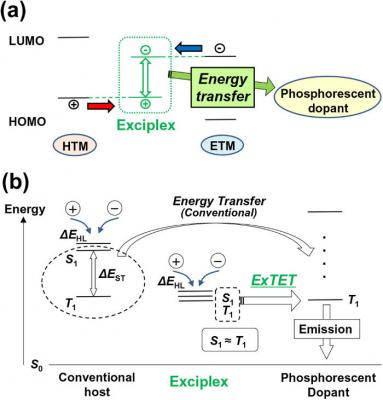Researchers from Japan's Semiconductor Energy Laboratory (SEL) developed a new OLED device architecture that enables efficient, long-lasting and low-drive voltage OLEDs, at practical brightness levels.
The researchers call the new device architecture exciplex-triplet energy transfer, or ExTET. The image above shows the elementary process and its energy state diagram. To create the emissive layer of the ExTET, the researcher took a film with an electron-transporting material (ETM) and a hole-transporting material (HTM) and doped it with a phosphorescent dopant. Direct recombination between the electrons at the LUMO level and the hole at the HUMO level forms a charge-transfer excited complex (exciplex) - and the phosphorescent emission occurs via energy transfer from the exciplex to the dopant.
The researchers fabricated several ExTET OLEDs (green, yellow, orange and red) and achieved extremely high external quantum efficiencies of about 30% with all those devices. This shows that the internal quantum efficiencies reached almost 100%. As they expected, the drive voltage was about 3V.
The research believe that ExTET will finally enable a phosphorescent blue OLED, and they are currently working to produce the first such material.



Nice news but not impressive.
I'll really start to be excited when I'll see solid data concerning lifetime.